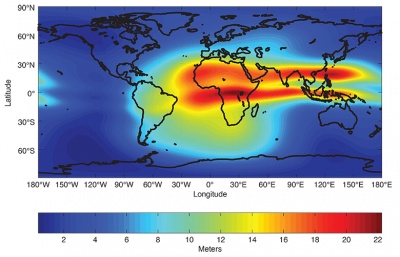If you wish to contribute or participate in the discussions about articles you are invited to contact the Editor
NeQuick Ionospheric Model
| Fundamentals | |
|---|---|
| Title | NeQuick Ionospheric Model |
| Author(s) | J. Sanz Subirana, J.M. Juan Zornoza and M. Hernández-Pajares, Technical University of Catalonia, Spain. [Updated 2017]: R. Prieto-Cerdeira, R. Orús Pérez, European Space Agency, ESA/ESTEC. |
| Level | Intermediate |
| Year of Publication | 2011, updated 2017 |
NeQuick-G is the ionospheric model adopted by the Galileo system in order to help to compute the ionospheric delay corrections for its single-frequency users [Galileo Open Service-Ionospheric Correction Algorithm, 2016] [1]. The NeQuick-G model is an adaptation for real-time users of the ITU-R NeQuick ionospheric electron density model [ITU-R, 2013] [2] based on the original profiler proposed by [Di Giovanni and Radicella, 1990][3] [Hochegger, Nava et al., 2000][4].NeQuick a three-dimensional and time dependent ionospheric electron density model based on an empirical climatological representation of the ionosphere, which predicts monthly mean electron density from analytical profiles, depending on solar-activity-related input values: sun spot number or solar flux, month, geographic latitude and longitude, height and Universal Time (UT).
NeQuick model has been adapted for real-time Galileo single-frequency ionospheric corrections (for convenience referred to as NeQuick-G) in order to derive real-time predictions based on a single input parameter, the Effective ionisation level, Az, which is determined using three coefficients broadcast in the navigation message. As a three-dimensional and time-dependent model, it has the capability to provide vertical or slant ionospheric delay correction by integrating the predicted electron density along the line of sight vector between satellite and receiver.
In order to take into account both daily variation of the solar activity and the user’s local geomagnetic condition, the NeQuick-G model is driven by and computes its correction by use of the daily solar activity information, so-called effective ionization level (Az) expressed in solar flux unit (10-22Wm-2Hz-1)
For Galileo single-frequency users, Galileo satellites broadcast three ionospheric coefficients in their navigation message that are used to compute the Az as follows [Galileo - Open Service SIS-ICD, 2016] [5]:
- [math]\displaystyle{ Az=a_0+a_1\mu + a_2 \mu^2 \qquad\mbox{(1)} }[/math]
where [math]\displaystyle{ \mu }[/math] is the modified dip latitude, or MODIP:
- [math]\displaystyle{ \tan \mu=\displaystyle \frac{I}{\sqrt{\cos \phi}}\qquad\mbox{(2)} }[/math]
being [math]\displaystyle{ I }[/math] the true magnetic inclination[footnotes 1], or dip in the ionosphere (usually at 300 km), and [math]\displaystyle{ \Phi }[/math] the geographic latitude of the receiver [Rawer, 1963][6].
The coefficients [math]\displaystyle{ a_0 }[/math], [math]\displaystyle{ a_1 }[/math],[math]\displaystyle{ a_2 }[/math] will be broadcasted to the users in the Galileo navigation message and updated at least once a day [footnotes 2].
The Galileo single frequency receiver algorithm will be based in the following steps (the next paragraph is taken from [Arbesser-Rastburg, B., 2006][7]):
- 1. [math]\displaystyle{ Az }[/math] is evaluated using [math]\displaystyle{ a_0 }[/math], [math]\displaystyle{ a_1 }[/math],[math]\displaystyle{ a_2 }[/math] (from navigation message) and MODIP from the NeQuick model (which depends on estimated receiver position).
- 2. Electron density is calculated for a point along the satellite to receiver path, using the NeQuick model with [math]\displaystyle{ Az }[/math] in place of [math]\displaystyle{ F10.7 }[/math].
- 3. Steps 1 and 2 are repeated for many discrete points along the satellite receiver path. The number and spacing of the points will depend on the height and they will be a trade-off between integration error and computational time and power.
- 4. All electron density values along the ray are integrated in order to obtain Slant TEC (STEC).
- 5. Slant TEC, in TECUs, is converted to meters of L1 slant delay for correcting pseudo-ranges, by
- [math]\displaystyle{ I_f = \frac{40.3\cdot 10^{16}}{f^2}TEC \qquad\mbox{(where f is in Hz)} \quad\mbox{(3)} }[/math]
An overview of the correction algorithm and initial performance results with broadcast parameters from Galileo satellites have been performed during IOV in the period April 2013 to March 2014 during solar maximum of Solar Cycle 24 [Prieto-Cerdeira, Orús-Pérez et al, 2014] [8].
Notice that, as with the Klobuchar model, the ionospheric corrections computed by the NeQuick G can be used for any GNSS signal (GPS, GLONASS, Galileo…) simply by setting the corresponding frequency in the equation (3).
Notes
References
- ^ European Union (2016). European GNSS (Galileo) Open Service-Ionospheric Correction Algorithm for Galileo Single Frequency Users. 1.2.
- ^ ITU-R (2013). Ionospheric propagation data and prediction methods required for the design of satellite services and systems. Recommendation ITU-R P. 531-12.
- ^ Di Giovanni, G. and Radicella, S. M., 1990. An analytical model of the electron density pro_le in the ionosphere. Advances in Space Research. 10(11), pp. 27-30.
- ^ Hochegger, G., B. Nava, S. Radicella and R. Leitinger (2000). “A family of ionospheric models for different uses”. In: Physics and Chemistry of the Earth, Part C: Solar, Terrestrial & Planetary Science 25.4, pp. 307–310. issn: 1464-1917. doi: 10.1016/ S1464-1917(00)00022-2.
- ^ Galileo - Open Service - Signal-In-Space Interface Control Document (2016). “European GNSS (Galileo) Open Service, Signal-In-Space Interface Control Document.” Issue 1.3, December 2016.
- ^ Rawer, K., 1963. Propagation of decameter waves (HF-band), in Meteorological and Astronomical Inuences on Radio Wave Propagation. Ed. Landmark, B. Pergamon Press, New York.
- ^ Arbesser-Rastburg, B., 2006. The Galileo Single Frequency Ionospheric Correction Algorithm. European Space Weather Week, Brussels
- ^ Prieto-Cerdeira, R., R. Orús-Pérez, E. Breeuwer, R. Lucas-Rodríguez and M. Falcone (2014). ‘Innovation: The European Way. Performance of the Galileo Single-Frequency Ionospheric Correction During In-Orbit Validation’. In: GPSworld 25.6, pp. 53–58.

